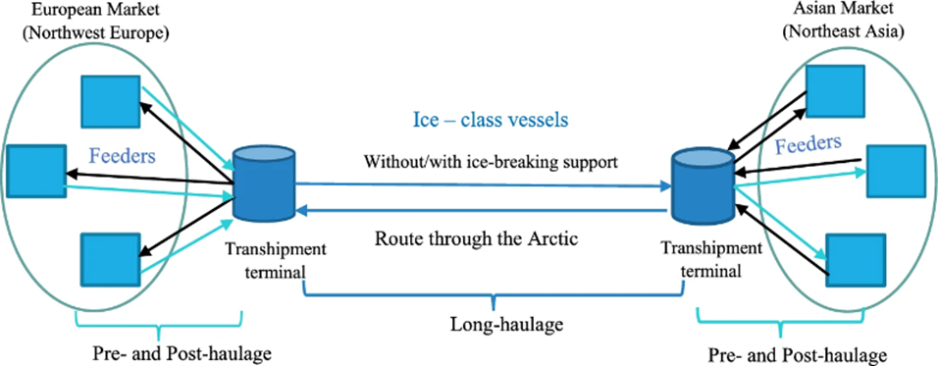Op-ed: Charting a Greener Course: The Northeast Passage and Shipping’s Future

Researchers Terje Mathisen and Alina Kovalenko have studied opportunities for shipping along the Northeast Passage. (Photo: Birgitte Annie Martinussen)
Op-ed: Global shipping faces unprecedented challenges as reliance on established trade routes like the Suez Canal exposes vulnerabilities in current trade networks. From the infamous Ever Given blockage to the increasing political risks in the Middle East, the need for exploring alternative routes is urgent, writes researchers from Nord University in this op-ed on the Northeast passage.
This is an op-ed written by external contributors. All views reflected are the authors' own.
Global shipping faces unprecedented challenges as reliance on established trade routes like the Suez Canal exposes vulnerabilities in current trade networks.
From the infamous Ever Given blockage to the increasing political risks in the Middle East, exploring alternative routes is urgent.
A recent study, “Generalized Transport Costs in Intermodal Shipping: The Context of the Northeast Passage,” conducted by researchers from Nord University and Delft University of Technology, offers a fresh perspective, urging us to rethink how we evaluate transport routes—not merely by focusing on monetary costs but also by considering resources related to time use and damage costs.
A framework including such elements would give a more correct view of how the Northeast Passage (NEP) could be a valuable supplement to global trade as a new, efficient, and resilient option.
A comprehensive framework
Traditionally, shipping cost comparisons have focused on easily accessible monetary factors, such as fuel, labor, and vessel maintenance.
Monetary costs are well-known expenses like fuel, distance, and time charter costs.
However, adopting the generalized transport cost framework to the maritime Arctic routes demonstrates a more nuanced approach by giving monetary value to the three categories of monetary costs, time costs, and damage costs.
Monetary costs are well-known expenses like fuel, distance, and time charter costs. Time costs are opportunity costs related to shipping duration, which can be substantial for time-sensitive cargo groups.
Finally, damage costs are associated with risks and damage potential, which vary based on weather conditions and specific requirements of the goods.
This generalized cost framework provides a more holistic view of shipping costs, facilitating a fair comparison of traditional routes like the Suez Canal with NEP solutions.
With this approach, shippers and policymakers can make more informed decisions about the NEP’s potential as a viable alternative.
However, even if the generalized cost approach includes most of the consequences for alternative transport solutions, the approach has weaknesses when it comes to the monetary valuation of effects.
Particularly, it has been criticized for not capturing external effects on the environment, which are important aspects when assessing the welfare impacts on society.
The intermodal transport solution: a flexible but costly solution
Intermodal transport is praised for its potential to improve sustainability. The concept can be applied to the NEP by combining different shipping methods, including pre-and post-haulage, transshipment in intermodal terminals, and ice-class vessels for ice-covered waters.
The goal is to exploit the advantages of both ice-free and ice-class vessels where suitable, which, in principle, would allow greater flexibility and reduced unit cost.

Intermodal transport solution for year-round transit shipping through the NEP. (Adapted from Milaković et al. 2018)
Despite these advantages, intermodal solutions are not yet cost-competitive with either unimodal Arctic solutions or the Suez Canal.
They incur increased pecuniary costs and time use of transshipment operations, which in most scenarios outweigh fuel savings of shorter routes and the lower charter rates of non-ice class feeders to be applied in some zones of the NEP.
Furthermore, the transshipment operations increase damage costs, making them less ideal for high-value cargo.
Consequently, economic competitiveness remains challenging for intermodal solutions to be a preferred alternative for sustainable Arctic shipping.
Sensitivity analysis demonstrates that establishing an efficient transshipment infrastructure, including specialized cranes and port development, is crucial to improving their appeal.
Also read (the text continues)
With strategic investment, particularly aimed at high-value cargo, the NEP could gradually overcome these cost barriers. Hence, it is relevant for policymakers to know that investments to provide efficient port infrastructure that reduces time in transshipment are vital.
The unimodal solution: cost-efficiency with high ice-class vessels
The unimodal solution, understood as transit transport by the same vessel of sufficiently high ice class from the origin to the destination without transshipment, offers a set of advantages.
This approach uses high-class ice vessels, notably the Arc 7 container ships, designed to navigate icy waters without requiring icebreaker support under most weather conditions.
Using available data to the generalized cost model, the study reveals that unimodal solutions, especially with high ice-class vessels, result in approximately 57% lower transport costs for high-value cargo than an average route over the Suez Canal.
Reducing transit time and avoiding transshipment fees make this an economically attractive choice, especially for time-sensitive and highly valuable goods.
A reliable and well-established infrastructure.
Even though less prominent, unimodal shipping also offers generalized cost advantages for medium and low-value cargo compared to intermodal Arctic solutions and even to the Suez Canal.
Suez Canal vs. Northeast Passage: a competitive analysis
The Suez Canal, long regarded as the default East-West trade route, has traditionally been recognized as a reliable and well-established infrastructure.
However, incidents like the Ever Given blockage, piracy risks, and political tension in the Middle East region reveal its vulnerability to delays and disruptions, highlighting the necessity of exploring alternatives.
In comparing the Suez Canal with the NEP, it becomes evident that:
- The Suez Canal is reliable but prone to delays due to its high traffic and single-route configuration, where an incident can halt traffic.
- Intermodal NEP routes offer sustainability potential but are currently less competitive from a generalized cost perspective due to high transshipment and damage costs.
- Unimodal NEP routes using high ice-class vessels are more cost-effective for high-value cargo, presenting a viable alternative for shippers with the right fleet and infrastructure.
Navigating decarbonization: policies, regulations, and NEP opportunities
Regulations and policies remain central to decarbonizing shipping by setting clear requirements and incentives.
Also read (the text continues)
The International Maritime Organization (IMO) is implementing its Greenhouse gas (GHG) strategy with targets to reduce emissions by 20-30% by 2030, 80% by 2040, and achieve net zero by 2050.
Regulations under this timeline will be adopted by 2025 and enforced from mid-2027, focusing on measures like reducing marine fuel GHG intensity and implementing emissions pricing mechanisms for international maritime shipping.
In parallel, the European Union's Fit for 55 package aims to cut emissions by 55% by 2030, requiring shipowners and operators to manage reductions via the EU ETS and FuelEU regulations. For the Arctic, specific regulations are underway.
Key measures include the IMO's prohibition on heavy fuel oil (HFO), which takes full effect by 2029, and stricter emission limits in designated Emission Control Areas (ECAs) in the Canadian Arctic and the Norwegian Sea.
Additionally, the IMO continues to develop policies to reduce Black Carbon emissions in the region, potentially by introducing polar fuel standards under MARPOL Annex VI.
The study’s sensitivity analysis highlights time savings
The Northeast Passage offers a shorter route, potentially reducing CO₂ emissions and environmental impact, provided safeguards protect the fragile Arctic ecosystem.
The study’s sensitivity analysis highlights time savings as the NEP’s primary advantage, particularly for high-value cargo less affected by port fees or fuel prices.
Stakeholders can leverage this by adjusting rates for price-insensitive users to fund Arctic infrastructure, balancing profitability with sustainability.
Importantly, regulatory costs or fines to incentivize environmentally responsible behavior must be substantial, aligning with the IMO’s broader efforts to regulate international shipping.
Future research directions: integrating environmental costs
The generalized cost model presented in the observed study could be refined and extended to consider environmental aspects by including external costs and thereby better take into consideration all relevant effects for society as a whole.
Also read (the text cont)
External costs are relevant to include if we are to discuss environmental aspects such as sustainability in the fragile Arctic region, but at the moment it is challenging to find available data on measures for calculating the impact on the environment.
Policymakers must prioritize transparency and data collection to address these gaps.
Priorities for NEP development: a policy and infrastructure roadmap
For NEP to be a long-term alternative, it requires strategic investments and policy support. Key priorities identified in the study include:
- Efficient transshipment infrastructure (especially cranes) is critical to improving the competitiveness of NEP routes in the case of intermodal shipping. Policymakers should prioritize port development, which is particularly relevant for high-value cargo.
- To finance infrastructure upgrades, stakeholders could consider increasing rates for less price-sensitive users, as port fees and fuel costs are less impactful on high-value cargo.
- Policies that enforce environmental responsibility through large fines or pecuniary costs are necessary to incentivize operators toward environmentally friendly practices.
- Researchers and stakeholders must collaborate to gather empirical data, especially sensitive information such as icebreaker availability, to refine models and validate assumptions. Many of these data are difficult to access, as they are often controlled by the state.
The Path Forward: Is the NEP a Feasible Supplement to Global Trade Flow?
The NEP offers an enticing alternative to the Suez Canal. The potential for significant cost savings and shorter transit times, particularly with unimodal solutions using advanced ice-class vessels, is attractive for high-value cargo.
Yet, achieving a commercially viable and environmentally sustainable route through the Arctic is no small feat. Policymakers and industry leaders must address existing challenges with infrastructure, transparency, and environmental safeguards.
By adopting the study’s comprehensive cost framework, stakeholders can make data-driven decisions that maximize the NEP’s potential while mitigating its risks.
If developed responsibly, the NEP could not only enhance global trade resilience but also set new standards for efficient and diversified trade routes in an increasingly complex world.
As shipping companies and governments look to fortify the world’s trade networks, the NEP could become a crucial player in a new era of global trade—one that represents a move towards efficiency, resilience, and sustainability rather than maintaining the status quo.






